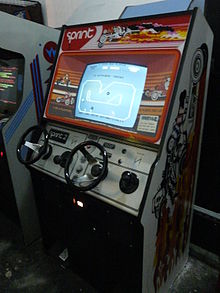Sprint 2
| Sprint 2 | |
|---|---|
 | |
| Developer(s) | Kee Games |
| Publisher(s) | |
| Designer(s) | Dennis Koble & Lyle Rains |
| Platform(s) | Arcade |
| Release | |
| Genre(s) | Racing |
| Mode(s) | One-player or two-player game |
Sprint 2 is a two player overhead-view arcade racing video game released in 1976 by Kee Games,[3] a wholly owned subsidiary of Atari, and distributed by Namco in Japan.[2] While earlier driving games had computer-controlled cars that moved along a "canned predetermined" course, Sprint 2 "introduced the concept of a computer car that had the intelligence to drive itself around the track" in "a semi-intelligent" manner.[4]
Development[edit]
The team that developed Sprint 2 consisted of Dennis Koble, Howard Delman, and Dan Van Elderen and Lyle Rains. Both Koble and Rains do not recall who came up with the idea for the game. Rains would recall in an interview with Retro Gamer that the game most likely game from "Atari never wanting to be too far from the release of a new and improved driving game. The Gran Trak 10, Gran Trak 20, Indy 800 and LeMans games had been consistent moneymakers for Atari and its customers."[5]
The game was one of Atari's first mass-produced Microprocessor based games. Rains recalled the game was the microprocessor allowed them to make the game faster and more exciting than any earlier racing games. Koble recalled he had to immerse himself in 6502 programming for the game.[5] Sprint 2 was designed to be an update of the previous games, leading the team to removed unwanted features, such as driving in reverse from Gran Trak 20 as well as removing a break pedal as stepping off the gas was the equivilant of a brake. Other features remained such as the timer, with Rains stating that it had not occured to the team to base the game around laps over a timer.[5]
Sprint 2 first racing game that introduced the concept of a computer-controlled car that had the intelligence to drive itself around the track without a canned predetermined course based on how well the player was doing.[6] Rains stated that this was his idea. To do so, he created a map of vectors to tell the computer-controlled cars which way they should drive. They would align themselves to the current vector and drive themselves around the track in a non-repeating path.[7] Koble created the graphics for the game, stating that the artists employed by Atari at the time were only making side panel and control panel artwork and were not involved with the games creation.[7]
Reception[edit]
In the United States, Sprint 2 was the second highest-earning arcade video game of 1977, below Sea Wolf.[8][9] It was also second highest-earning arcade video game of 1978, below Space Wars, along with Sprint 1 in third place.[10] Sprint 2 was later the third highest-earning arcade video game of 1979, below Space Invaders and Atari Football.[11]
The game was a commercial success for Namco in Japan, where Sprint 2 was the seventh highest-earning arcade video game of 1977. It was also among the year's top four highest-earning racing video games, below Taito's Speed Race DX and Road Champion, and tied with Taito's Super High-Way.[12]
Legacy[edit]
Sprint 2 was the first in a long series of games, some of which bore its name into the 1980s:
- Sprint 4 and Sprint 8, a 4 player and 8 player version respectively, were released in 1977. Both were full color raster versions of the game.
- Sprint 1 was released in 1978. The "1" and "2" designations reflect the number of players, rather than indicating it was a prequel.
- Super Sprint, a 3 player version with updated graphics, was released by Atari Games in 1986.
- Championship Sprint, a 2 player version of Super Sprint, was released by Atari Games in 1986.
- Badlands, a 2 player post-apocalyptic setting update of Championship Sprint, was released in 1989.
Sprint 2 was one of the first Atari products to feature the now well-known "Atari arcade font" (first introduced in the Quiz Show).[13]
In 2016 a reverse engineered version to JavaScript became available.[14]
References[edit]
- ^ a b "Video Game Flyers: Sprint 2, Kee Games (Germany)". The Arcade Flyer Archive. Retrieved 24 May 2021.
- ^ a b c "スプリント2中村製作所販売" [Sprint 2 Nakamura Seisakusho Sales]. Media Arts Database. Agency for Cultural Affairs. Retrieved 24 May 2021.
- ^ "Sprint 2 Killer List of Video Games Entry". Retrieved 2007-08-21.
- ^ "An Interview with Dan Van Elderen". Next Generation. No. 35. Imagine Media. November 1997. p. 81.
- ^ a b c Jones 2011, p. 38.
- ^ Charla 1997, p. 81.
- ^ a b Jones 2011, p. 39.
- ^ "Top Arcade Games". Play Meter. November 1977.
- ^ "Profit Chart". RePlay. November 1977.
- ^ "Video Games". RePlay. November 1978.
- ^ "Video Games". RePlay. November 1979.
- ^ "結果ベスト3" [Best 3 Results] (PDF). Game Machine (in Japanese). No. 90. Amusement Press, Inc. 15 February 1978. pp. 2–3.
- ^ "The 8-bit arcade font, deconstructed". Vox. YouTube. April 6, 2020. Archived from the original on 2021-12-21.
- ^ Forty-Year-Old Arcade Game Reveals Secrets of Robot Path Planning on hackaday.com by Dan Maloney (April 28, 2016)
Sources[edit]
- Jones, Darran, ed. (2011). "The Making of... Sprint 2". Retro Gamer. No. 89. Imagine Publishing. ISSN 1742-3155.
- Charla, Chris, ed. (November 1997). "An Interview with Dan Van Elderen". Next Generation. Imagine Publishing. ISSN 1078-9693.
External links[edit]
- Commentary from GameSpy
- Commentary from Phosphor Dot Fossils
- Sprint 2 at the Killer List of Videogames
- Entry at the Arcade Flyer Archive
- Sprint 2[permanent dead link] at ArcadeStuff
- Sprint 2 at GameFAQs
